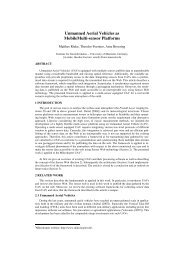A Conceptual Workflow For Automatically Assessing The ... - Agile
A Conceptual Workflow For Automatically Assessing The ... - Agile
A Conceptual Workflow For Automatically Assessing The ... - Agile
Create successful ePaper yourself
Turn your PDF publications into a flip-book with our unique Google optimized e-Paper software.
AGILE 2011, April 18-22: Frank O. Ostermann, Laura Spinsanti<br />
VOLUNTEERED GEOGRAPHIC INFORMATION AND DISASTER<br />
MANAGEMENT<br />
In this section, we briefly describe in which phases of the disaster/hazard management cycle<br />
volunteered information can play an important role.<br />
<strong>The</strong> public has already been strongly involved in natural disasters and has often provided a<br />
substantial amount of information (Palen and Liu 2007). However, the recent and expected increase in<br />
VGI on natural disasters, coupled with the heterogeneous and unstructured form of data, is going to<br />
change the way information is collected, distributed and used. <strong>The</strong> web 2.0 has given the public the<br />
opportunity to share and learn from their experiences through texts (blogs), photos (Flickr, Picasa,<br />
Panoramio, …) and maps (GoogleMaps, GoogleEarth, …), not only seeking but also providing<br />
information. A further boost of this trend has been the additional possibility to reach an even larger<br />
number of people in near real-time through social media platforms like Twitter and Facebook. This<br />
increasing amount of bi-directional horizontal peer-to-peer information exchange also affects the<br />
traditional uni-directional vertical flow of information (Hughes et al. 2008). Traditional broadcasting<br />
media open up to micro journalism and several official administrative agencies already adapt and use<br />
third-party social media accounts for communicating information (Latonero and Irina Shklovski<br />
2010). However, incorporation of VGI into the administrative established emergency protocols has<br />
not advanced significantly. It seems that public officials view such volunteered information mainly as<br />
a threat that could spread misinformation and rumor (Sutton et al. 2008). Examples of research on the<br />
role of VGI during concrete disasters are manifold (De Longueville, Luraschi, et al. 2010; De<br />
Longueville, Smith, and Luraschi 2009; Hudson-Smith et al. 2009; Liu and Palen 2010), still a lot of<br />
open question remain to be investigated. Among the others, we argue that that the increasing amount<br />
of information renders a manual filtering of incoming information infeasible. Our proposed workflow<br />
tries to automatize as many steps as feasible.<br />
WORK FLOW CONCEPT: FROM COLLECTING VGI TO INTEGRATION WITH<br />
SDI<br />
To give a brief overview we propose the high level workflow in Figure 1. It starts with the<br />
retrieval of data from various social media sources on a specific topic, i.e. forest fires. Depending on<br />
the type of crisis event, several public institutions can provide additional input. Here, the European<br />
<strong>For</strong>est Fire Information Service (EFFIS, effis.jrc.ec.europa.eu) is used as an example. <strong>The</strong>n, this data<br />
is validated syntactically and formatted according to the needs of later processing phases. <strong>The</strong><br />
validated and formatted data is then enriched with additional information, mainly about the location,<br />
but also about the source. <strong>The</strong> main aim is to assess the quality of this enriched VGI: what is its<br />
overall credibility and what is its relevance for actual forest fire events. Once these metrics have been<br />
determined, the data is integrated with existing SDIs, before the dissemination phase makes the<br />
results available to the two intended target audiences of decision-makers and citizens. It is important<br />
to note that at the current exploratory stage of research, we have not yet defined on purpose any<br />
logical or physical aspects of the workflow, such as storage format, output formats, or service<br />
architecture. Each phase is explained in a subsection, with the focus on the processing phase.<br />
Retrieval<br />
Figure 1: Overview of work flow<br />
<strong>The</strong> retrieval phase can have different levels of complexity. A very simple approach is to use<br />
keywords related to the disaster category. Thus, in the forest fire case, the words wildfire, fire, forest<br />
could be used. However, this simplistic approach has several limitations that ignore important<br />
2




